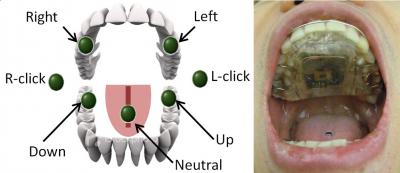Researchers at the Georgia Institute of Technology have developed a prototype of a Tongue Drive, a wireless device developed to allow patients with severe spinal cord injuries to maneuver electrically powered wheelchairs or operate computers by moving their tongues. The intraoral Tongue Drive System was demonstrated at San Francisco’s IEEE International Solid-State Circuits Conference on 20th February, 2012.
 Circuitry for the intraoral Tongue Drive System
Circuitry for the intraoral Tongue Drive System
The intraoral prototype is a dental retainer with embedded sensors. The sensors are capable of tracking the exact location of a miniature magnet placed on the patient’s tongue. The appliance includes a lithium-ion battery as well as an induction coil to recharge the battery. The entire circuitry is placed on the retainer and is covered with a water-resistant, insulating material and is vacuum-molded within the dental acrylic.
An associate professor at the Georgia Institute of Technology’s School of Electrical and Computer Engineering, Maysam Ghovanloo stated that the Tongue Drive System provides better comfort and increased mechanical stability. The development of the Tongue Drive System was supported by the National Science Foundation, the National Institutes of Health and the Christopher and Dana Reeve Foundation.
The sensors output signals are transmitted wirelessly to an iPhone or iPod, where the installed software infers the commands by determining the magnet’s relative position in real-time. The interpreted data is used for controlling the wheelchair’s joystick function or used to move the cursor on the screen of the computer.
The researchers will soon begin testing the usabilityof the new intraoral Tongue Drive System followed by clinical trials.